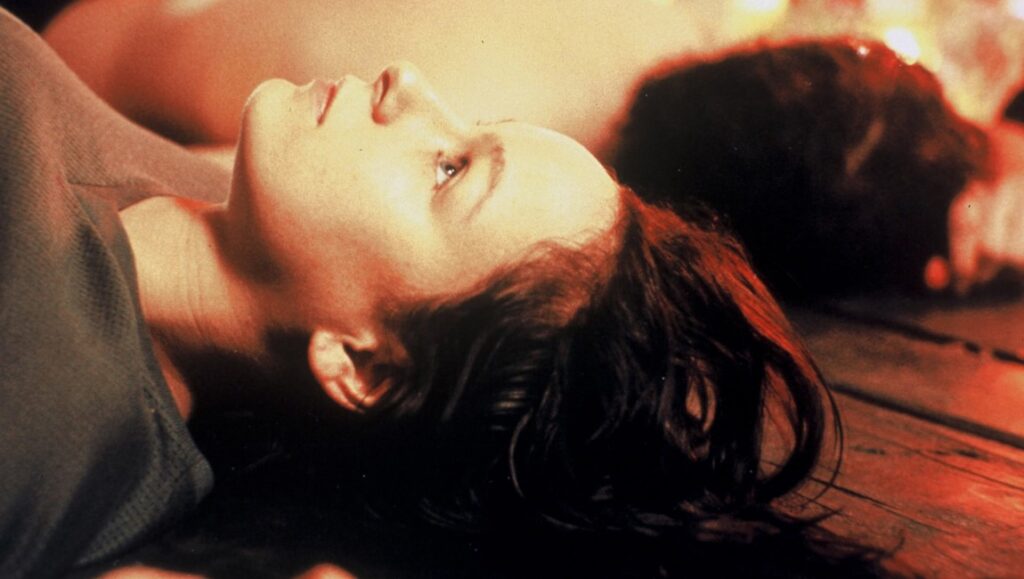“READ ME”: a visage lit in orange glow, hands, bodies, hands caressing bodies, the twinkling lights of a Christmas tree, the two words blinking mutely from a desktop screen, silence. So opens — in oneiric, inert fashion — Morvern Callar, a palimpsest of orange, beige, and grayscale, set to the disquieting rhythm of a society whose margins aren’t quite defined, perhaps not definable, whose success stories overwhelm the silent failures amidst them. Morvern Callar (Samantha Morton), a supermarket clerk, is one such failure, working dead-end retail at the age of twenty-one and betrothed to her recently deceased boyfriend, a writer leaving behind a hole to his head, his corpse on the apartment floor, a copy of his manuscript, and his suicide note which beckons: “READ ME.” These two words, appearing only fleetingly, arguably constitute the film’s clarion call to the viewer, an injunction for the bourgeois outsider to peer into, and find poetry in, the lives of their poorer others.
But what, or who, is there to be read? Lynne Ramsay, in just her second feature, establishes a mature tonal register far beyond the purview of most sophomore efforts. Poetic realism, as Renoir or Vigo would have it, has witnessed a comeback in British cinema under Tony Blair, somewhat distinct from the kitchen-sink variety fostered by Ken Loach and Mike Leigh insofar as the latter’s socialist roots are now imbued with a lyricism heavily indebted to the tactile screen: shots of objects and household minutiae in focus, their coarse, lived textures reclaimed by the gently gliding lens, as in the pair of glasses sitting morosely at the bottom of a canal in Ramsay’s debut Ratcatcher or in the dingy poverty of an apartment interior, lit by the light of summer, in Andrea Arnold’s Fish Tank. In Morvern Callar, silence complements these shots, rendering them still; like still life, an aura pervades through the celluloid, resisting the medium’s mechanically reproducible images by imprinting some trace of historicity to its objects and some glimpse of psychological interiority to its people.
Ramsay’s Morvern takes to the exotic environs of Spain soon after her boyfriend’s death, seeking to rediscover herself and rechart the course of her life. But paradoxically, her mobility on the road is matched by her aimlessness, a stasis that takes flight in both her head and our own as we navigate the dim alleys of Scotland, before wandering the Andalusian desert, alongside Morvern and her co-worker and best friend Lanna (Kathleen McDermott). Struggling to articulate her thoughts in words, Morvern translates them into action: she passes off her boyfriend’s manuscript as her own, feigning aloof innocence in front of her prospective publishers who’ve traveled down to Spain to meet her, and she hooks up at the hotel with a man who’s just lost his mother. All of these little impulses — transient, mysterious, ambivalent — are keenly immortalized under Ramsay’s watchful, loving gaze and afforded symbolic eminence in lieu of overt political commentary. Little exposition or contextualization is deemed necessary in her case; the focus lies, instead, with Morvern’s deeply subjective experience, a heartfelt struggle to comprehend (or simply exist in) a world in which grief and futility have assumed near-total control.
Therein lies the filmmaker’s creative mark and also marked curse: for all her earnest and perspicuous examination of the outsiders in an otherwise globalized suburbanity, Ramsay’s works bear her worst tendencies of mistaking the abstruse for the profound, of fomenting aestheticized sympathy where contradictions and lived reality do more justice to the constituents of her gaze. Ratcatcher’s exhumation of working-class squalor in 1973 Glasgow, for example, tempers realism with the coming-of-age imagination of twelve-year-old James Gillespie, effectively allowing misery-laden stereotypes of wayward youth to puncture and permeate the narrative under the guise of impressionism; We Need to Talk About Kevin, her follow-up to Morvern Callar, similarly banks on Ezra Miller’s unknowable, abject tour de force to elicit one-dimensional fascination toward its eponymous character. The critical debate, despite consensus toward praise, has always centered around the politics of representation: does Ramsay empower the working class through her compositions, or does she inadvertently romanticize their struggles and attitudes? It’s a question that her elliptical, shadowy evocations of milieus tend shy away from, an uneasy dynamic between filmmaker and filmed reinscribed into, and thus neutered by, the distractions of film grain.
Armond White’s description of Ratcatcher — as emblematic of a “Boutique Socialism” — demonstrates, for all its loaded antipathy for the latter term, a cultural acquiescence toward poverty as refracted through the lens of unfiltered film photography. With Morvern Callar, Ramsay’s ideological engagements are spelt out; rather than politicizing the margins, she displays a penchant for poeticizing them. The subtexts of its relationships — Morvern and her boyfriend, Morvern and Lanna, Morvern and the publishers — are present, but defiantly couched within interpretations just out of reach. We wager Morvern’s unequal, unhappy life under the influence of an intellectual, we posit her willingness to take credit for his work as confused, vengeful, or simply lazy opportunism. There’s no denying the indelible impact of poetry, written or visual, but in this case the marriage between both forms is itself unequal: the latter’s spontaneity foiled by the former’s scarcity. Ultimately, the bitter taste that remains after the reading, whether for Morvern or for us, curdles into flattened sympathy. That, for better or for worse, is Ramsay’s acclaim in poetry and realism, two fields whose crops cannot both aspire to the same fecundity but have, thanks to her, done so.
Part of Kicking the Canon – The Film Canon.
Published as part of InRO Weekly — Volume 1, Issue 2


Comments are closed.